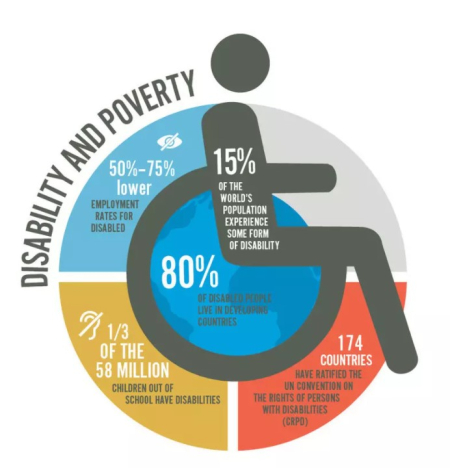- One in six people worldwide have a disability – and faces economic exclusion.
- Ensuring digital transformation includes disabled people also brings larger economic benefits.
- Technology in the areas of edtech, fintech, remote working and networking can all further inclusion.
Totalling over 1 billion people globally, people with disabilities – those whose hearing, visual, cognitive, mobility, speech or neural functions are impaired – are the largest minority group in the world. Their inclusion and empowerment is essential, as it not only benefits the person with disabilities, but also family members, who are more likely to leave their jobs to take care of relatives in this situation.
With digital transformation sweeping the world towards the Fourth Industrial Revolution, it is imperative to ensure people with disabilities are not excluded from the workforce of the future. Digital transformation linked with edtech, remote working, fintech and networking can drive people with disabilities towards greater success and help to tap into their potential and unique skill set.
With one in six people globally having disabilities, disability inclusion is vital. Unlike gender, race or age, addressing disability inclusion is very challenging as 70% of disabilities are invisible, and many choose to not be open about them. People with disabilities are 50% less likely to get jobs, and even the jobs they perform tend to be at the lower corporate levels. People with disabilities with an advanced degree earn $21,000 less annually than people without disabilities, though they have the same education levels.
The problem starts at a young age, as children with disabilities are much less likely to complete their primary education. According to Dell, 85% of the jobs due to be available in 2030 have not yet been invented, so reskilling and upskilling disabled people with 21st-century skills, such as creativity, communication and critical thinking, can propel them to be in a stronger position in this constantly evolving world of work.
Driving disability inclusion is rewarding for organizations. Studies show that employees with disabilities bring improved productivity and increased innovation. An Accenture study shows that companies that were identified as disability-inclusion champions had 28% higher revenue. Sixty-six per cent of consumers will purchase from a company that features disabled people in its advertising, which shows the reputational benefits.
People with disabilities have twice the unemployment rate than those without, which as well as being detrimental in itself also means a loss of potential consumers. Excluding people with disabilities from the workforce can lead to a loss in GDP of up to 7%.
Though digital transformation can and will leave people with disabilities behind in certain aspects, it can also drive disability inclusion in fintech, edtech, remote working and networking:
Fintech
Households with disabilities are three times as likely to be unbanked as those with no disabilities. This means they have no spending records, resulting in reduced access to financial assistance and loans. Visiting banks in person can be a daunting task for disabled people, in addition to the time and cost of traveling. Fintech provides convenience, financial records and safety. It can provide personalized financial services with assistive technology to people with disabilities, helping them to overcome barriers to inclusion.
Edtech
Many students with disabilities face physical barriers to access to education, as many schools lack the facilities needed. Travelling to and from school can be challenging not only for students using wheelchairs, but also students with autism who are more sensitive to sound and light, which can make public transport (and classrooms) very stressful. Edtech gives access to education from the comfort of their own homes, where it is easier for them to be cared for by family members.
Online education also helps equalize disabled students with the rest of the class, as certain disabilities are not visible when communicating online, and the curriculum can be tailored to meet disability requirements. Advances in edtech are also making communicating with peers smoother, allowing disabled students to debate and discuss better. Braille-enabled accessories, hearing aid-compatible headsets, sign language translating software and text-to-speech tools are a few examples of how edtech can help in this regard. With edtech making it possible for disabled students to learn from home, it also prepares students for the future of work, which is going to be more hybrid.
Remote working
For many people with disabilities, remote working can open up a wider range of job opportunities, as travelling is a major impediment. Disabled people may require specialized equipment, accessibility facilities, communication tools and parking allocation among other things, which can make employers biased against hiring them. But remote working removes these barriers: It allows for better communications and may give more confidence to some disabled people as their disabilities are exposed less.
Remote working allows disabled people to create a tailor-made workspace taking into consideration all their needs, which is not always possible in a physical office. It also makes communicating for work much smoother; for example, Zoom’s automated closed captioning helps those with hearing disabilities. Lastly, it encourages employees to judge people with disabilities on the quality of their work, rather than on unconscious biases.
Networking
With a staggering 85% of jobs being filled by networking, it is vital for people with disabilities to make contacts. But in-person networking can be disconcerting for people with disabilities, as it requires travelling and can be late in the day making it inaccessible for many. Interacting casually in person may be dismaying for people with hearing disabilities or dyspraxia, making them less confident.
Platforms such as LinkedIn can be instrumental in connecting people with disabilities with potential recruiters whom they can meet over Zoom and build a relationship. With assistive technology and less exposure of their disabilities, disabled people can network better and more confidently.
Article originally posted on the World Economic Forum.
1Talal Rafi is a Development Economist and also specializes in Sustainability. He is a Senior Global Management Consultant at Deloitte and is based in Sri Lanka. He was on Deloitte's Global ESG Operations Team and he is a member of the Expert Network of the World Economic Forum
Note: The posts on the IMF PFM Blog should not be reported as representing the views of the IMF. The views expressed are those of the authors and do not necessarily represent those of the IMF or IMF policy.









